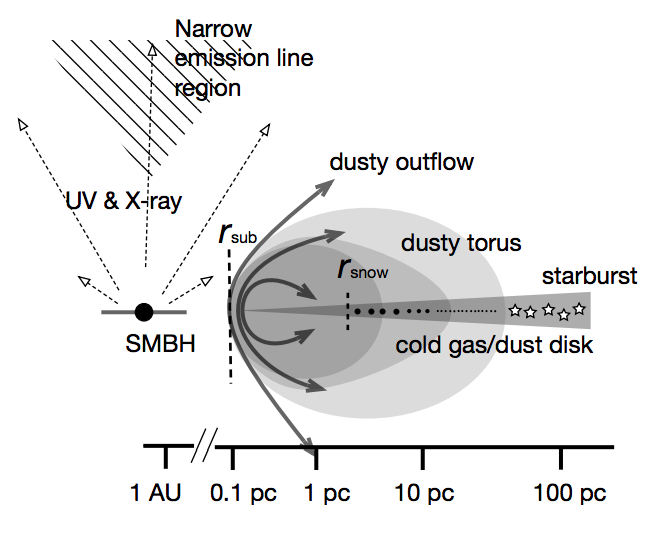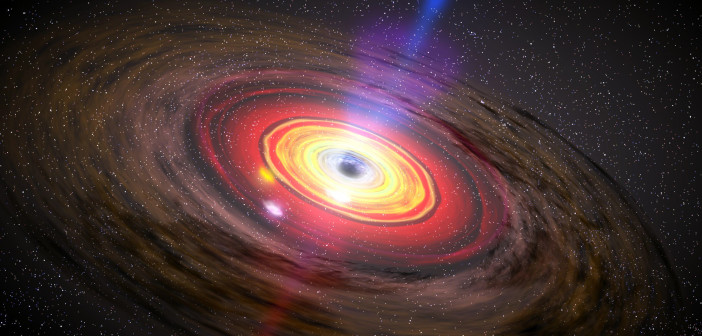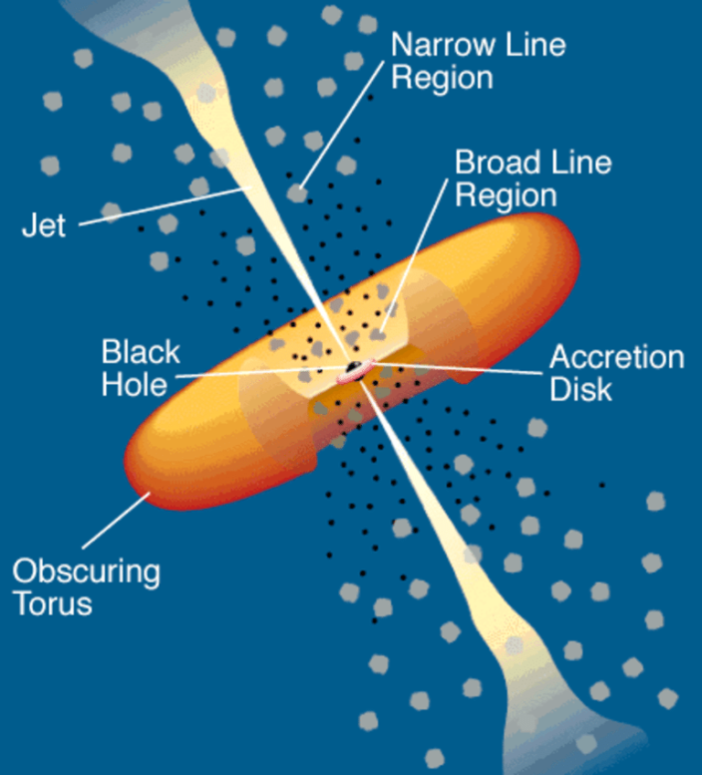Editor’s note: Astrobites is a graduate-student-run organization that digests astrophysical literature for undergraduate students. As part of the partnership between the AAS and astrobites, we occasionally repost astrobites content here at AAS Nova. We hope you enjoy this post from astrobites; the original can be viewed at astrobites.org.
Title: Planet Formation Around Super Massive Black Holes in the Active Galactic Nuclei
Authors: Keiichi Wada, Yusuke Tsukamoto, and Eiichiro Kokubo
First Author’s Institution: Kagoshima University, Japan
Status: Accepted to ApJ
Nearly 400 years ago, it was hypothesized that the planets in our solar system formed from the leftover material that formed the Sun. This hypothesis is now widely accepted as the standard model for solar-system formation. We have even seen this process in action within other stellar systems thanks to radio telescopes like the Atacama Large Millimeter/submillimeter Array (ALMA).
We continuously focus on planets that form around stars. But what if planets could form around other astronomical bodies? After all, stars aren’t the only objects in the universe that become surrounded by a tumultuous disk of gas and dust during their lives.
Active galactic nuclei (AGN) exist at the center of galaxies. The standard model for an AGN consists of a supermassive black hole and a hot accretion disk, both of which are surrounded by a donut-shaped (or torus-shaped) region of gas and dust. This configuration is shown in Figure 1. Today’s paper takes a look at how a planet could possibly form within the dusty torus around an AGN.
A Tumultuous Environment
AGN, as their name implies, are active objects. Gas fed to the AGN from an accretion disk acts as the fuel for these galactic engines, generating the high luminosities that allow us to observe these structures over vast distances. The material surrounding this central engine is where our interest lies. An AGN’s dusty torus spans a region from 0.1 parsecs (~0.3 light years) to tens of parsecs (~30 light years) away from the central supermassive black hole (SMBH), as shown in Figure 2. The inner region of the torus is heated by the central engine, and outflows of dust send material back to the interstellar medium. These structures have even been recently imaged with ALMA. However, their internal structure remains less well-understood.
Recent simulations have shown that the internal structure of a dusty torus is stratified. Figure 2 shows the disk of cold gas and dust within the dusty torus. The authors modeled the temperature distribution within this disk as a function of the AGN luminosity, finding that ices can form in regions ~1 parsec away from the central black hole, past the AGN’s snow line, and showing that the dynamics within this system could lead to these ices coalescing. The authors then took a look at how planets could grow within this environment.

Schematic diagram of an AGN, showing the central supermassive black hole, locations of different types of emission, and structure within the dusty torus. We can see the cold disk where planets could form, along with the location of the snow line, rsnow. [Wada et al. 2019]
Snowballing Planets
Stepping back to classical planet formation, as a cloud collapses to form a protostar, that star becomes surrounded by a protoplanetary disk — a disk of gas and dust that surrounds the protostar and is a source of accreting stellar material. Along with providing material for the star to grow from, a protoplanetary disk is also the site of planet growth, as its name implies. Dust particles in this disk collide with and stick to other particles to form planetesimals, larger bodies that act as the building blocks of planets. Planetesimals are large enough to attract other material via their own gravity, and they can eventually grow to planets via this accretion process.
The authors of today’s paper focus on the growth of planets from icy dust particles, which could form in the disk beyond the aforementioned AGN snow line. They tested systems of varying dust-particle sizes and analyzed the particles’ growth over time via numerical models. By analyzing the dust growth within systems of different black hole masses and disk viscosities, the authors determined that planet-sized bodies are capable of forming around low-luminosity AGN. The environments around quasars and other high-luminosity AGN, however, would not support planet formation.
Life Around a Black Hole?
Unfortunately, any planets that would form around AGN would be nearly impossible to detect using current methods. Even if we were to detect these planets, these systems would not assist humanity in its quest to understand the formation of habitable worlds. As mentioned previously, the environments around AGN are harsh, and they contain overly processed material that would make forming a habitable planet extremely difficult. Additionally, the amount of high-energy radiation from the black hole itself would cause any planet that formed there to be incapable of holding onto an atmosphere, an essential ingredient to life as we know it.
Although this study cannot be confirmed observationally and would not assist us in understanding habitable planets, this is an interesting look into where in the universe planets can form. The universe is, and will continue to be, a wild place.
About the author, Ellis Avallone:
I am a second-year graduate student at the University of Hawaii at Manoa Institute for Astronomy, where I study the Sun. My current research focuses on how the solar magnetic field triggers eruptions that can affect us here on Earth. In my free time I enjoy rock climbing, painting, and eating copious amounts of mac and cheese.

